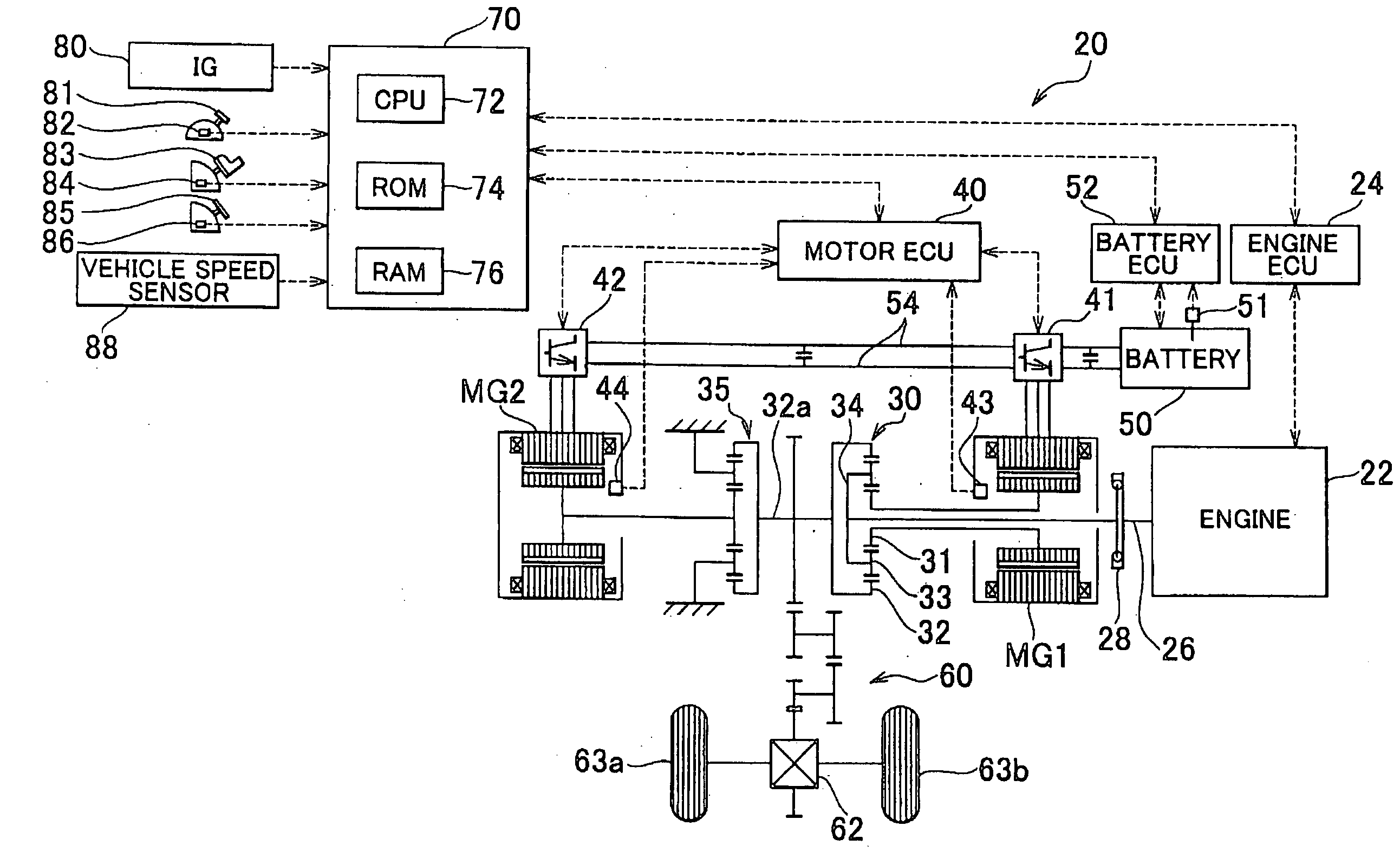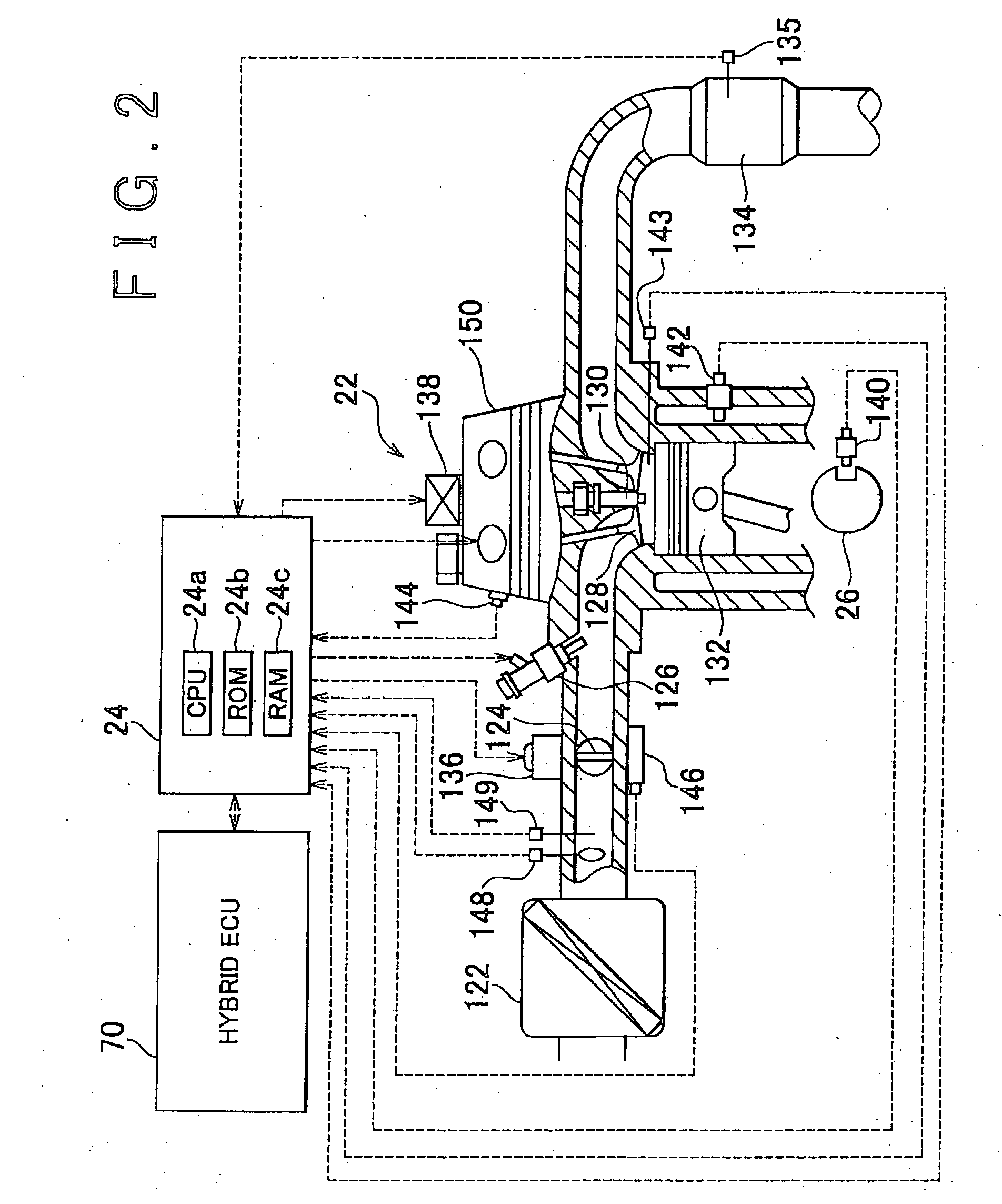[0007]The invention provides a
hybrid vehicle in which reduction of the
NOx purification efficiency of an
exhaust gas purification catalyst is suppressed when selection of one of the operation
modes which define respective different ranges, where a required drive power required to cause the vehicle to run can be set, is allowed, and a method for controlling such
hybrid vehicle. The invention also provides a
hybrid vehicle in which reduction of the
NOx purification efficiency of an
exhaust gas purification catalyst is suppressed to purify the exhaust gas more effectively, and a method for controlling such hybrid vehicle.
[0010]In the hybrid vehicle according to the first aspect of the invention, the execution
operation mode is set to one of the multiple operation
modes which define respective different ranges where a required drive power required to cause the vehicle to run. The multiple operation modes include the predetermined
operation mode at which the driver is allowed to select any one of the operation modes included in the predetermined
operation mode. When the driver is not allowed to select any one of the operation modes included in the predetermined operation mode, the target air-fuel ratio for the
internal combustion engine is set under the first constraint. On the other hand, when the driver is allowed to select any one of the operation modes included in the predetermined operation mode, the target air-fuel ratio is set under the second constraint. Under the second constraint, the target air-fuel ratio is set to a value richer than the target air-fuel ratio set under the first constraint. The
internal combustion engine, the
electric power / power reception /
output device, and the
electric motor are controlled so that the air-fuel ratio in the internal
combustion engine becomes equal to the set target air-fuel ratio, and the drive power corresponding to the required drive power set according to the set execution operation mode is output. Namely, when the driver is allowed to select any one of the operation modes, it is assumed that fuel-supply cutoff in response to an instruction to decelerate the vehicle will be performed relatively frequently. If no measures are taken in such a case, the NOx purification efficiency may be reduced, because a great amount of air is supplied to the exhaust gas purification catalyst due to fuel-supply cutoff and, therefore, oxygen adheres to the exhaust gas purification catalyst. To avoid such inconvenience, when the driver is allowed to select any one of the operation modes included in the predetermined operation mode, the target air-fuel ratio is set to a value richer than the target air-fuel ratio set when the driver is not allowed to select any one of the operation modes included in the predetermined operation mode. Thus, the amount of oxygen supplied to the purifying device can be reduced before fuel-supply is
cut off or when fuel-supply is restarted after fuel-supply is
cut off. As a result, even if a relatively great amount of air is supplied to the purifying device when fuel-supply is
cut off, reduction in the NOx purification efficiency of the catalyst is suppressed, and, consequently, exhaust gas is purified more effectively.
[0011]The hybrid vehicle according to the first aspect of the invention may further include a catalyst warm-up determination device that determines whether warm-up of the purifying device has been completed. The target air-fuel ratio setting device may set the target air-fuel ratio under the second constraint, when the driver is allowed to select any one of the operation modes included in the predetermined operation mode and it is determined that warm-up of the purifying device has not been completed. Generally, if a great amount of air is supplied to the exhaust gas purification catalyst due to fuel-supply cutoff while the purifying device has not been warmed sufficiently, the NOx purification efficiency of the catalyst may be reduced significantly. Accordingly, when the driver is allowed to select any one of the operation modes and it is determined that warm-up of the purifying device has not been completed, the target air-fuel ratio is set to a richer value. As a result; it is possible to suppress reduction in both
fuel efficiency and NOx purification efficiency of the catalyst.
[0016]As in the hybrid vehicle to which the method is applied, when the driver is allowed to select any one of the operation modes included in the predetermined operation modes, it is assumed that fuel-supply cutoff in response to an instruction to decelerate the vehicle will be performed relatively frequently. In such a case, the NOx purification efficiency may be reduced, because a great amount of air is supplied to the exhaust gas purification catalyst due to fuel-supply cutoff and, therefore, oxygen adheres to the exhaust gas purification catalyst. To avoid such inconvenience, when the driver is allowed to select any one of the operation modes included in the predetermined operation mode, the target air-fuel ratio is set to a value richer than the target air-fuel ratio set when the driver is not allowed to select any one of the operation modes included in the predetermined operation mode. Thus, the amount of oxygen supplied to the purifying device can be reduced before fuel-supply is
cut off or when fuel-supply is restarted after fuel-supply is cut off. As a result, even if a relatively great amount of air is supplied to the purifying device when fuel-supply is cut off, reduction in the NOx purification efficiency of the catalyst is suppressed, and, consequently, exhaust gas is purified more effectively.
 Login to View More
Login to View More  Login to View More
Login to View More 


